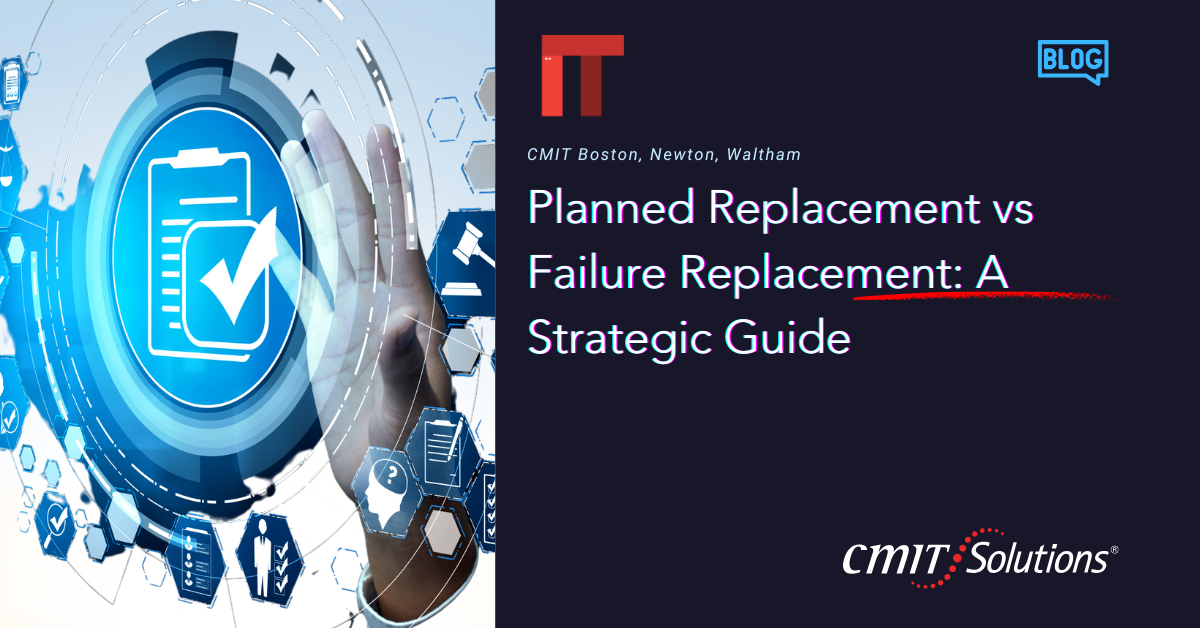Microsoft ends support for Windows 10 on October 14, 2025. For small and mid-sized businesses (SMBs) in Boston, Newton, and Waltham, this shift represents both a challenge and an opportunity. Planning ahead with the right IT strategy can mean the difference between a seamless transition and costly downtime. This guide, brought to you by CMIT Solutions of Boston, Newton, and Waltham, explores why a planned replacement strategy almost always outperforms a failure replacement approach.
Planned Replacement
A planned replacement strategy means proactively replacing devices before they break down or become unsupported. It offers peace of mind, budget predictability, and uninterrupted business continuity.
Benefits include:
- Predictable IT budgeting goals
- Less downtime and fewer disruptions
- Stronger cybersecurity compliance and control
- Consistent endpoint management and user productivity
Businesses planning ahead can also factor in cloud migrations and integration of collaboration tools.
Failure Replacement
In contrast, the failure replacement method involves waiting until equipment breaks down. While this may appear cost-saving at first, it often results in:
- Unplanned downtime
- Stressful and expensive emergency support
- Unexpected data loss or security gaps
- Lower staff productivity and increased frustration
Businesses relying on old hardware are more vulnerable to cyber threats, often missing out on data backup protections.
Cost vs Risk
Ultimately, the difference between these two approaches boils down to risk management. Planned replacement spreads out costs in a predictable way and minimizes surprises. Failure replacement risks high-impact incidents that can derail operations.
For instance, with managed IT services, you can monitor system health, apply proactive patches, and build resilience into your IT infrastructure.
A PC Lifecycle Example
Let’s break down the typical lifecycle cost of a business desktop:
- Hardware/software: $1,600
- Setup labor: $400
- Maintenance: $100/month
Across 4 years, this totals around $6,800 or $142/month. This investment ensures smooth performance, system compatibility, and reliable service.
The Risk of Waiting
Stretching device use to 8 years might save upfront costs—but the risks rise exponentially:
- $360 in urgent service (out-of-scope)
- $320 in productivity loss (1 day offline)
- $320 for rushed hardware
That’s over $1,000 in unplanned cost for a single failure. Add rising cyber insurance requirements and licensing delays, and the price of waiting grows.
Risk & Quality Tradeoff
Trying to save $11/month by using outdated systems comes at the cost of:
- System instability
- Lower employee satisfaction
- Missed revenue due to downtime
Outdated tech increases vulnerabilities—leaving you exposed to threats like phishing scams and ransomware.
Strategic Benefits of Proactive Planning
Planned upgrades give you time to:
- Train employees on new tools like remote collaboration
- Deploy cloud services
- Protect data with zero-trust architectures
- Align tech strategy with long-term growth
Final Thoughts
CMIT Boston, Newton, and Waltham recommends planning for the Windows 10 transition now—not when systems fail. From healthcare compliance to retail operations, our tailored IT strategies ensure long-term value.
Whether you’re leading a startup or managing enterprise workflows, future-proof your infrastructure and security with proactive IT planning.
Let’s talk: Visit CMIT Solutions of Boston, Newton, and Waltham to schedule a consultation today.







